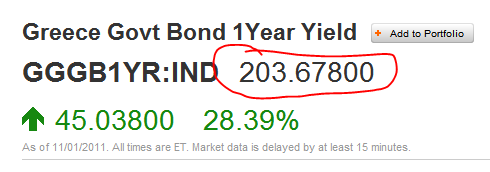On Monday I had a screenshot of the yield on 1 year Greek bonds which showed a “yield” of 192.61%. After it seemed that there was a plan for the Eurozone, that yield dropped closer to the 150% range, but after the Greek announcement that they would put the bailout plan to a referendum… well, people went ape s#it. The yield closed the day over 203%.
I had a question from a reader that I thought was worth sharing:
Q: Ok – so walk me through the math here – if I buy a $100 bond November 1st, it’s supposed to pay me $192 over the year and then return my capital next November. Right? Even if yield is cut in half ($96) and the value of the bond itself is cut in half ($50) – I’d still have $146 next November – which is a 50% gain. What’s so bad about that? Feel free to explain this to me like I’m a six-year-old.
First, keep in mind not all bonds come with a coupon, but regardless, the 192% number, and now the 203% number, is the Yield To Maturity. This factors in the current price, any coupon payments (which are assumed to be reinvested), and the time to maturity and converts it into an annualized return figure.
To have a yield to maturity of 200% means a 1 year zero coupon bond would be priced at about $333 (par of $1,000). This is probably in Euros for the Greek bonds of course, but you see what I mean. So if they don’t get re-structured, you would pay $333 now and one year later get $1,000. 200% is a tripling of your money.
To have a 1 year bond that is supposed to mature at $1,000 but is currently trading at $333 means few people believe that this will happen.
If they default you could lose all your money. If there is a 50% haircut the par value would be $500 and you make a healthy return of 50% (buy at $333, sell at $500). If the haircut is 70%, par is $300 and you lose 10% (buy at $333, sell at $300). Some think the 50% haircut is not enough.
Then there is the risk and return trade off. The secondary market is pricing the bonds now and there are lots of opinions as to what is going to happen, and how much compensation is required for risk in buying these bonds. If you are right you stand to make a lot of money. Just like if you were right with betting on a speculative penny stock. And just like a speculative penny stock, you could also lose a lot of money (if not all).
